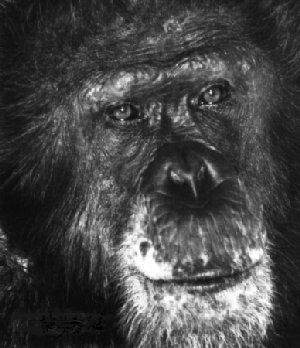![]()

BooeeÆs fate would have remained unknown to the public, had not American
TV Producer Dean Irwin heard about The Great Ape Project. He contacted
Peter Singer and Roger Fouts,
one of the contributors to the book The Great Ape Project. Roger
had known Booee long ago, and taught him sign language. They speculated
on whether a chimpanzee could remember someone over many years. Dean decided
to bring Roger across the United States and film his reunion with Booee.
A Chimpanzee Never Forgets?
The result was screened by ABCÆs 20/20 program in the US, and on A Current Affair in Australia in which Peter Singer also appeared. Booee not only remembered Roger, he remembered the sign for his own name, and his nickname sign for Roger, as well as several other signs. The saddest part of the film was when Roger had to go, leaving Booee in his bare cage.
Shortly after their parting, Roger wrote:
ôMany of you may have seen the 20/20 piece on my reunion with Booee,
televised May 5, 1995. It was something that I did not want to do and now
understand why. Booee is in my dreams. I see him over and over again moving
away from me, with a heart-rending demeanor, as I tell him I must leave.
I had hoped that he would not recognize me, and would see me as just one
more lab-coated visitor passing through the facility. But Booee recognized
me immediately; after 17 years, he remembered me, and it was as if time
had not passed. We were playing the same games and our relationship had
not changed. He was still the dear little boy who had taught me so much
during my fledgling years as a new Ph.D. I was torn by the joy of finding
an old and dear friend and the heartache of knowing that I would have to
leave him in a few short hours. Was it worth it? I do not know. I can only
hope that the effect on the viewers who watched and became aware of the
plight of captive chimpanzees was worth the pain Booee and I suffered when
I told him I had to leave.ö
From Tool of Science to One of the Familyà
Although Roger worked with Booee in sign language experiments, Booee was æownedÆ by another laboratory. Roger was unable to stop him being taken away for other, much more sinister, experiments.
Booee was born at a biomedical facility. The staff were unaware that his mother was pregnant, so BooeeÆs arrival came as a surprise. He was an unexpected addition to the facility, and no plans had been made to use him in a specific study. He was a æfreeÆ chimp, an unexpected bonus. He thus became a chance to try out new, æhotÆ procedures that are only read about in journals. Booee made his first mistake when he was a few days old. He convulsed, prompting some of the researchers to suspect that he was epileptic.
The æhotÆ topic in those days was æsplit brainÆ operations, recently discovered to alleviate grand mal seizures. So Booee had his brain split when he was only a few days old. This operation was relatively benign. It involved cutting all the connections between the two cerebral hemispheres, in essence giving Booee two separate brains. There were a few problems. Booee developed edema, and the surgeons had to open his cranium again to relieve the pressure.
Fortunately, one of the doctors, Fred Schneider, took pity on this poor little chimp in agonizing pain, and with the bandaged head. He took him home to recuperate with his family of six children.
BooeeÆs new home proved to offer a great life. His surrogate parents enjoyed having him there, and he became very attached to his human mother and to his new family. When he was 10 months old, the family went wilderness camping and didnÆt think that they could take him along. He was left with babysitters. He had become so attached to the Schneiders that he fell into a depression, developed pneumonia, and was close to death when the family returned. Fortunately, he recovered. At the age of three, his human parents began to discover that baby chimps are very much like human babies. They demand mothering and go through different phases as they grow up. For example, the living room drapes became vines to climb on, and cupboards had to be locked to prevent an inquisitive chimp with a æsweet toothÆ from raiding the larder.